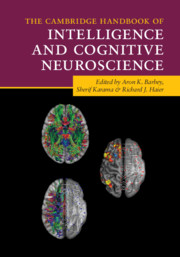Book contents
- The Cambridge Handbook of Intelligence and Cognitive Neuroscience
- Reviews
- The Cambridge Handbook of Intelligence and Cognitive Neuroscience
- Copyright page
- Dedication
- Contents
- Figures
- Tables
- Contributors
- Preface
- Part I Fundamental Issues
- Part II Theories, Models, and Hypotheses
- Part III Neuroimaging Methods and Findings
- 10 Diffusion-Weighted Imaging of Intelligence
- 11 Structural Brain Imaging of Intelligence
- 12 Functional Brain Imaging of Intelligence
- 13 An Integrated, Dynamic Functional Connectome Underlies Intelligence
- 14 Biochemical Correlates of Intelligence
- 15 Good Sense and Good Chemistry
- Part IV Predictive Modeling Approaches
- Part V Translating Research on the Neuroscience of Intelligence into Action
- Index
- References
15 - Good Sense and Good Chemistry
Neurochemical Correlates of Cognitive Performance Assessed In Vivo through Magnetic Resonance Spectroscopy
from Part III - Neuroimaging Methods and Findings
Published online by Cambridge University Press: 11 June 2021
- The Cambridge Handbook of Intelligence and Cognitive Neuroscience
- Reviews
- The Cambridge Handbook of Intelligence and Cognitive Neuroscience
- Copyright page
- Dedication
- Contents
- Figures
- Tables
- Contributors
- Preface
- Part I Fundamental Issues
- Part II Theories, Models, and Hypotheses
- Part III Neuroimaging Methods and Findings
- 10 Diffusion-Weighted Imaging of Intelligence
- 11 Structural Brain Imaging of Intelligence
- 12 Functional Brain Imaging of Intelligence
- 13 An Integrated, Dynamic Functional Connectome Underlies Intelligence
- 14 Biochemical Correlates of Intelligence
- 15 Good Sense and Good Chemistry
- Part IV Predictive Modeling Approaches
- Part V Translating Research on the Neuroscience of Intelligence into Action
- Index
- References
Summary
Intelligence is an extensively researched and psychometrically robust construct, whose biological validity remains insufficiently elucidated. The extant theorizing about neural mechanisms of intelligence links better reasoning abilities to the efficiency of information processing by the brain as a system (Neubauer & Fink, 2009), to the structural and functional integrity of the network connecting critically important brain hubs (a parietal-frontal integration or P-FIT theory, Jung & Haier, 2007), and to properties of specific brain regions, such as the prefrontal cortices (Duncan, Emslie, Williams, Johnson, & Freer, 1996). Gathering data for testing these theories is a complicated enterprise that involves interrogating the brain from multiple perspectives. Despite recent promising work on multimodal imaging (Sui, Huster, Yu, Segall, & Calhoun, 2014), it is still unrealistic to assess all relevant aspects of the brain at once. Thus, the investigators are compelled to evaluate specific salient features of the brain’s structure and function.
- Type
- Chapter
- Information
- Publisher: Cambridge University PressPrint publication year: 2021



